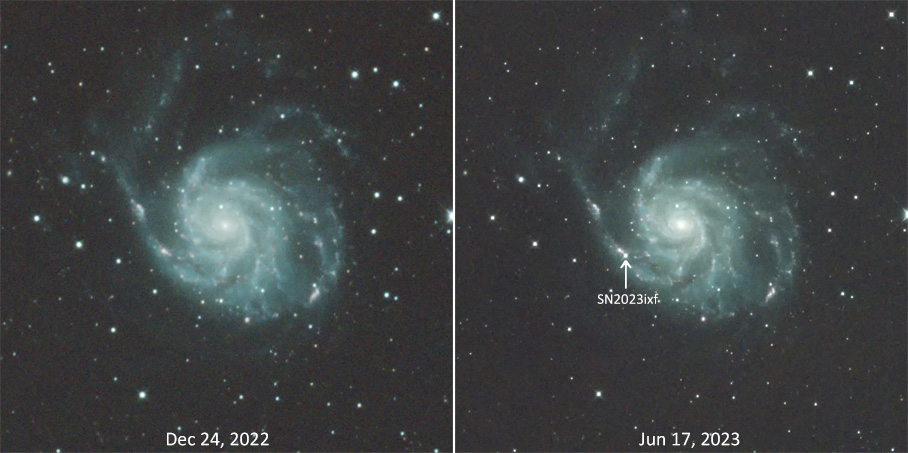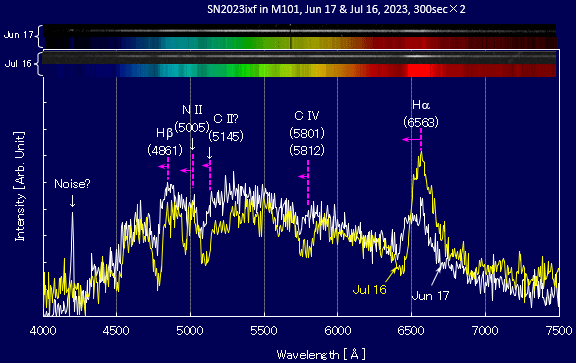| Date & Time: | (Left) Dec 24 2022, from 27:53 to 28:33 JST(+0900), 8min.×6shots |
| (Right) Jun 17 2023, from 22:37 to 23:21 JST(+0900), 6min.×8shots |
| Optical: | TAKAHASHI 16cm(6.3") epsilon (f=530mm, F3.3) |
| with IDAS LPS-D1 Light-pollution suppression filter |
| Auto-guided with TAKAHASHI JP Equatorial+SBIG STV |
| CMOS Camera: | ZWO ASI2600MC Pro (Cooled temp.: -25°C(Dec 24), -15°C(Jun 17)) |
| Location: | Ooizumi, Hokuto city, Yamanashi pref. |
Absorption lines on Jun 17, 2023
| Absorption line | Hβ | C IV | C II |
|---|
| Observed WL, λm | 4775 Å | 5739 Å | 5078 Å |
| WL in literature, λ0 | 4861 Å | 5812 Å | 5145 Å |
| Blue shift, z | 1.77×10-2 | 1.26×10-2 | 1.30×10-2 |
| Closing velocity, V(km/s) | 5.26×103 | 3.74×103 | 3.88×103 |
| Expanding velocity, V'(km/s) | 5.62×103 | 4.10×103 | 4.24×103 |
Absorption lines on Jul 16, 2023
| Absorption line | Hβ | C IV | C II | N II |
|---|
| Observed WL, λm | 4791 Å | 5785 Å | 5101 Å | 4954 Å |
| WL in literature, λ0 | 4861 Å | 5812 Å | 5145 Å | 5005 Å |
| Blue shift, z | 1.44×10-2 | 4.65×10-3 | 8.55×10-3 | 1.02×10-2 |
| Closing velocity, V(km/s) | 4.29×103 | 1.39×103 | 2.55×103 | 3.04×103 |
| Expanding velocity, V'(km/s) | 4.65×103 | 1.75×103 | 2.91×103 | 3.40×103 |
z= (λ0-λm)/λ0
V= c*((1+z)2-1)/((1+z)2+1)
V'= V + 360 km/s (Recession velocity of M101)
|
This is the comparison of spectral images and intensity distributions of SN2023ixf observed on June 17 and July 16, 2023, approximately one and two months after its appearance.
During May 2023, numerous emission spectral lines of light elements such as hydrogen, nitrogen, and carbon were observed.
However, at the time of this capture, the supernova's expelled stellar atmosphere had spread significantly, leading to the residual light of only the Hƒ¿ emission line being detectable.
Additionally, broad absorption lines of Hβ, ionized carbon (C II and C IV), and ionized nitrogen (N II, detected only Jul 16) were observed, albeit indistinctly.
From the observed wavelengths of the absorption lines in the supernova's spectrum,
it is possible to estimate the line-of-sight velocity (i.e., expansion velocity) associated with the explosion.
The table on the right shows the expansion velocities derived from the blue-shifts of the minimum wavelengths of three absorption lines.
It should be noted that the Hα line is excluded from the analysis due to the broadening of the emission line, which hinders accurate wavelength determination.
The recession velocity of M101 itself due to cosmic expansion is approximately 360 km/s, and accounting for that,
the estimated average expansion velocity (V') of the supernova explosion ranges approximately 4600 and 3200 km/s on Jun 16 and Jul 17, respectively.
It is confirmed that the blast wave is decelerating as the days pass.
⇒ Back to M101
|


